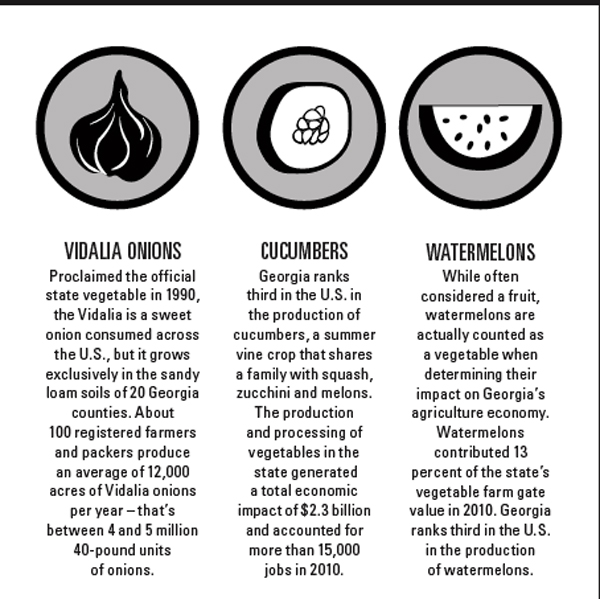Home > Georgia > Georgia Crops & Livestock > Vidalia Onions and Other Vegetables Contribute to Georgia’s Economy
Vidalia Onions and Other Vegetables Contribute to Georgia’s Economy

Much of Georgia’s climate and soil favors vegetable production, as evidenced by its top-five state ranking.
Vegetables earn a noticeable space on the pie chart for Georgia’s most valuable agriculture products, ahead of forestry, fruits and nuts. The state’s own Vidalia onion takes the biggest slice of the veggie pie accounting for nearly 19 percent of the state’s vegetable value. The trademarked sweet onion is consumed across the country, but grows exclusively in the sandy loam soils of 20 Georgia counties.
“It’s just unique because the Vidalia onion is such a large industry with a big economic impact on the state of Georgia, especially in the growing area that it’s in,” says Aries Haygood, general manager of M&T Farms, which grows Vidalia onions, watermelon and pecans in Lyons. “What better way to show homegrown and locally grown than being from the state of Georgia? Folks who enjoy the onion can actually see it being harvested, grown and processed, all of the above.”

The production and processing of vegetables in Georgia generated a total economic impact of $2.3 billion and accounted for more than 15,000 jobs in 2010, according to the University of Georgia. With its mild winters and irrigation access, south Georgia produces vegetables year-round, from Vidalia onions in winter to watermelons in summer. Northeast Georgia produces a small but significant vegetable crop, dominated by cabbage, collard, sweet corn, tomato and pumpkin, the university reports.
Nationwide, Georgia ranks second in spring onion production and third in cucumbers, sweet corn and watermelon, according to the National Agricultural Statistics Service. The state also ranks fourth in snap beans and fifth in bell peppers. The Vidalia onion, Georgia’s most valuable vegetable, possesses a farm gate value of around $150 million annually, says Wendy Brannen, executive director of the Vidalia Onion Committee.
“We’re always among the top vegetable money-makers for the state of Georgia,” she says.
The Vidalia Onion: a Sweet Accident
The Vidalia, dubbed “America’s favorite sweet onion,” started as a fluke. Georgia farmers in the 1930s planted onions as an alternative income source. To their surprise, the onions tasted mild. Word of mouth praised the onion, which increased in production in the late 1970s. Farmers eventually banded together to define the onion’s characteristics, trademark it and begin national distribution. By 1990, the Vidalia onion became the official state vegetable.
“We are the pioneer sweet onion,” Brannen says. “We are the first to actually produce and market a sweet onion on any substantial level.”
Today, about 100 registered farmers and packers in a defined 20-county region grow and market the sweet onions, she says. The area includes a hub around the town of Vidalia in the middle of state. Farmers grow an average 12,000 acres of onions per year that require a seasonal workforce to plant and harvest by hand. They generally produce between four and five million 40-pound units of Vidalia onions per year, Brannen says.

Onion Life Cycle
M&T Farms in Lyons grows about 42 million Vidalia onions annually on 500 acres.
The vegetable grows for eight months. The onions start in concentrated seed beds in the fall, and by December workers transplant them at a rate of 85,000 plants per acre. For six months, Haygood monitors plant health, disease and insect pressures, nutrient uptake and water needs. Ironically, the onion’s biggest advantages and challenges lie in the weather. Georgia’s naturally moist environment, while ideal for vegetables, also favors disease.
Harvest occurs in late April and May. Onions generally require one laborer per 10 acres in the field and one per four acres in a farm’s packaging facility, Haygood says. M&T Farms often has 75 to 150 people in its sheds, where onions cure in special rooms. Workers then sort the onions by size and quality and place them in packages that will be shipped with the Vidalia and farm names.
The onion’s shelf life keeps it predominantly a domestic product. The Vidalia onion blankets the United States, with around 5 percent shipped into Canada, Brannen says. Sales of consumer packs, or packages of medium-size onions, have shown new growth. Brannen affirms the industry’s health and its deeply entrenched tradition in Georgia.
“We are known as the Peach State, but when I travel I find we’re just as well known for Vidalia onions as we are peaches,” she says.



